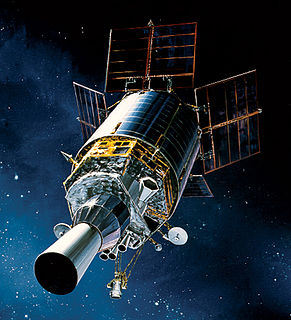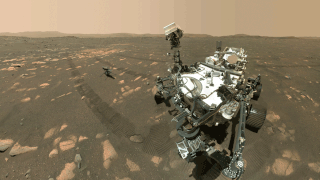Related Research Articles

The VehicleAssembly Building, or VAB, is the large building at NASA's Kennedy Space Center (KSC), designed to assemble the large pre-manufactured space vehicle components, such as the massive Saturn V and the Space Shuttle, and stack them vertically onto one of three mobile launcher platforms used by NASA. The future Space Launch System (SLS) will also be assembled there.

The planet Mars has been explored remotely by spacecraft. Probes sent from Earth, beginning in the late 20th century, have yielded a large increase in knowledge about the Martian system, focused primarily on understanding its geology and habitability potential. Engineering interplanetary journeys is complicated and the exploration of Mars has experienced a high failure rate, especially the early attempts. Roughly sixty percent of all spacecraft destined for Mars failed before completing their missions and some failed before their observations could begin. Some missions have met with unexpected success, such as the twin Mars Exploration Rovers, Spirit and Opportunity which operated for years beyond their specification.

STS-44 was a Space Shuttle mission using Atlantis that launched on 24 November 1991. It was a U.S. Department of Defense space mission.

A military satellite is an artificial satellite used for a military purpose. The most common missions are intelligence gathering, navigation and military communications.

The Defense Support Program (DSP) is a program of the United States Space Force that operated the reconnaissance satellites which form the principal component of the Satellite Early Warning System used by the United States.

Uncrewed spaceflights to the International Space Station (ISS) are made primarily to deliver cargo, however several Russian modules have also docked to the outpost following uncrewed launches. Resupply missions typically use the Russian Progress spacecraft, European Automated Transfer Vehicles, Japanese Kounotori vehicles, and the American Dragon and Cygnus spacecraft. The primary docking system for Progress spacecraft is the automated Kurs system, with the manual TORU system as a backup. ATVs also use Kurs, however they are not equipped with TORU. Progress and ATV can remain docked for up to six months. The other spacecraft — the Japanese HTV, the SpaceX Dragon and the Northrop Grumman Cygnus — rendezvous with the station before being grappled using Canadarm2 and berthed at the nadir port of the Harmony or Unity module for one to two months. Under CRS phase 2, Cargo Dragon will dock autonomously at IDA-2 or 3 as the case may be. As of April 2021, Progress spacecraft have flown most of the uncrewed missions to the ISS.

The Space-Based Infrared System (SBIRS) is a United States Space Force system intended to meet the United States' infrared space surveillance needs through the first two to three decades of the 21st century. The SBIRS program is designed to provide key capabilities in the areas of missile warning, missile defense and battlespace characterization via satellites in geosynchronous Earth orbit (GEO), sensors hosted on satellites in highly elliptical orbit (HEO), and ground-based data processing and control.

This comparison of orbital launch systems lists the attributes of all individual rocket configurations designed to reach orbit. A first list contains rockets that are currently operational or in development; a second list includes all retired rockets. For the simple list of all conventional launcher families, see: Comparison of orbital launchers families. For the list of predominantly solid-fueled orbital launch systems, see: Comparison of solid-fueled orbital launch systems.

The National Aeronautics and Space Administration is an independent agency of the U.S. federal government responsible for the civilian space program, as well as aeronautics and space research.

The Micro-satellite Technology Experiment (MiTEx) is a microsatellite-based mission launched into geosynchronous orbit 21 June 2006 aboard a Delta II rocket. The USAF described the mission as a "technology demonstration" for the Defense Advanced Research Projects Agency (DARPA), the United States Air Force (USAF) and the United States Navy.
NASA has hosted many events for its social media enthusiasts called NASA Socials beginning in 2009. These events are targeted at the social media followers of NASA through platforms such as Twitter, Facebook, Google Plus, Instagram, YouTube and more. They provide guests with VIP access to NASA facilities and speakers with the goal of leveraging participants' social networks to further the outreach requirements of NASA as laid out in the National Aeronautics and Space Act. NASA re-branded these events as "Socials" in March 2012 as it expanded participation to services beyond just Twitter.

This article documents notable spaceflight events during 2021.

SpaceX Crew-1 is the first operational crewed flight of a Crew Dragon spacecraft. It is also the first crewed night launch by the United States since that of STS-131 in April 2010. The Crew Dragon spacecraft Resilience launched on 16 November 2020 at 00:27:17 UTC on a Falcon 9 from the Kennedy Space Center, LC-39A, carrying NASA astronauts Michael Hopkins, Victor Glover and Shannon Walker along with JAXA astronaut Soichi Noguchi, all members of the Expedition 64 crew. The mission is the second overall crewed orbital flight of the Crew Dragon.

USA-289, also known as GPS-III SV01 or Vespucci, is an United States navigation satellite which forms part of the Global Positioning System. It was the first GPS Block III satellite to be launched.
USA-198, known before launch as NRO Launch 24 (NROL-24), is an American communications satellite that was launched in 2007.
References
- ↑ "NASA - NSSDCA - Spacecraft - Details". nssdc.gsfc.nasa.gov. Retrieved 2021-04-13.
- ↑ "DSP 14, 15, 16, 17, 18, 19, 20, 21, 22, 23 (Phase 3)". Gunter's Space Page. Retrieved 2021-04-13.